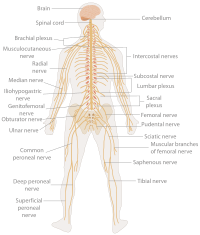
Anatomy of the physical examination: A small group learning approach for increasing engagement and learning in a medical gross anatomy course
Sign Up to like & getrecommendations! Published in 2021 at "Clinical Anatomy"
DOI: 10.1002/ca.23829
Abstract: The ability to perform and interpret the physical examination requires an understanding of human anatomy and how to apply that content in the clinical setting. Previous work has shown that students understand and retain information… read more here.
Keywords: anatomy course; anatomy; physical examination; small group ... See more keywords

Systematic review of patient history and physical examination to diagnose chronic low back pain originating from the facet joints
Sign Up to like & getrecommendations! Published in 2017 at "European Journal of Pain"
DOI: 10.1002/ejp.963
Abstract: Patient history and physical examination are frequently used procedures to diagnose chronic low back pain (CLBP) originating from the facet joints, although the diagnostic accuracy is controversial. The aim of this systematic review is to… read more here.
Keywords: pain; history physical; patient history; physical examination ... See more keywords

Comparing Physical Examination With Sonographic Versions of the Same Examination Techniques for Splenomegaly
Sign Up to like & getrecommendations! Published in 2018 at "Journal of Ultrasound in Medicine"
DOI: 10.1002/jum.14506
Abstract: To determine whether sonographic versions of physical examination techniques can accurately identify splenomegaly, Castell's method (Ann Intern Med 1967; 67:1265–1267), the sonographic Castell's method, spleen tip palpation, and the sonographic spleen tip technique were compared… read more here.
Keywords: examination techniques; examination; physical examination; comparing physical ... See more keywords

Accuracy of Medical Students in Detecting Pleural Effusion Using Lung Ultrasound as an Adjunct to the Physical Examination
Sign Up to like & getrecommendations! Published in 2018 at "Journal of Ultrasound in Medicine"
DOI: 10.1002/jum.14612
Abstract: This study compared the accuracy of medical students in identifying pleural effusion in hospitalized patients using the physical examination versus lung ultrasound (US). read more here.
Keywords: medical students; lung ultrasound; accuracy medical; physical examination ... See more keywords

Back pain from painful osteoporotic vertebral fractures: discrepancy between the actual fracture location and the location suggested by patient-reported pain or physical examination findings
Sign Up to like & getrecommendations! Published in 2020 at "Osteoporosis International"
DOI: 10.1007/s00198-020-05434-9
Abstract: Summary Caution is necessary when using symptom or physical examination findings to localize the osteoporotic vertebral fractures (VFs) attributable to the discrepant colocalized relationship. Introduction Whether the location of symptoms or physical examination findings delineates… read more here.
Keywords: patient reported; location; physical examination; examination findings ... See more keywords

The influence of students’ gender on equity in Peer Physical Examination: a qualitative study
Sign Up to like & getrecommendations! Published in 2017 at "Advances in Health Sciences Education"
DOI: 10.1007/s10459-016-9699-0
Abstract: Abstract Peer Physical Examination (PPE) is an educational tool used globally for learning early clinical skills and anatomy. In quantitative research, there are differences in students’ preferences and actual participation in PPE by gender. This… read more here.
Keywords: examination; physical examination; peer physical; students gender ... See more keywords

Degenerative Mitral Regurgitation: Assessment, Physical Examination, and Imaging
Sign Up to like & getrecommendations! Published in 2019 at "Current Cardiology Reports"
DOI: 10.1007/s11886-019-1163-3
Abstract: Purpose of ReviewIn this review, we provide a comprehensive approach to assess degenerative mitral regurgitation.Recent FindingsIn the evaluation of MR, it is important to differentiate between primary (degenerative/organic) MR in which an intrinsic mitral valve… read more here.
Keywords: regurgitation; regurgitation assessment; degenerative mitral; physical examination ... See more keywords

Physical Examination of the Hip: Assessment of Femoroacetabular Impingement, Labral Pathology, and Microinstability
Sign Up to like & getrecommendations! Published in 2022 at "Current Reviews in Musculoskeletal Medicine"
DOI: 10.1007/s12178-022-09745-8
Abstract: Determining the correct diagnosis can be challenging in patients presenting with hip pain. The physical examination is an essential tool that can aid in diagnosis of hip pathology. The purpose of this review is to… read more here.
Keywords: physical exam; hip; microinstability; physical examination ... See more keywords

Teaching clinical skills in the theatre of medicine
Sign Up to like & getrecommendations! Published in 2018 at "Perspectives on Medical Education"
DOI: 10.1007/s40037-018-0445-6
Abstract: Many doctors will fondly look back on their medical student days. Aside from grappling with theoretical knowledge, ‘hands-on’ experience was eagerly anticipated as they embarked on their journey as being doctors of the future. This… read more here.
Keywords: medicine; physical examination; clinical skills; teaching clinical ... See more keywords

Integration of ultrasound in medical School: Effects on Physical Examination Skills of Undergraduates
Sign Up to like & getrecommendations! Published in 2020 at "Medical Science Educator"
DOI: 10.1007/s40670-020-00921-4
Abstract: Introduction Ultrasound (US) imaging has rapidly increased its application in almost every medical field. Many universities worldwide provide teaching of US for undergraduates in their curricula. Emerging evidence is supporting the use of ultrasonography to… read more here.
Keywords: medical students; ultrasound medical; examination; physical examination ... See more keywords

Pulmonary nodules detection assistant platform: An effective computer aided system for early pulmonary nodules detection in physical examination.
Sign Up to like & getrecommendations! Published in 2022 at "Computer methods and programs in biomedicine"
DOI: 10.1016/j.cmpb.2022.106680
Abstract: BACKGROUND AND OBJECTIVE Early detection of the pulmonary nodule from physical examination low-dose computer tomography (LDCT) images is an effective measure to reduce the mortality rate of lung cancer. Although there are many computer aided… read more here.
Keywords: pulmonary nodules; nodules detection; computer; detection ... See more keywords